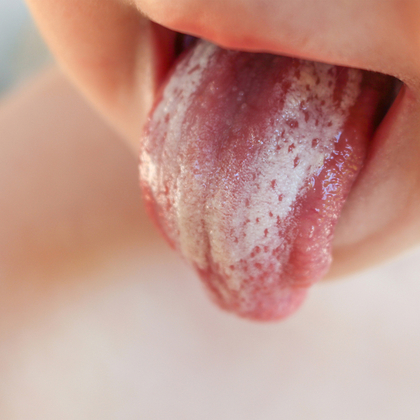Many people find it difficult to talk about an embarrassing health problem such as thrush. But the truth is, it’s a fairly common condition, especially among women.
Vaginal thrush affects around three out of four women at least once during their lives (i). It’s most likely to affect women in their 20s and 30s, with women who have been through the menopause and girls who haven’t started their periods the least likely to be affected (ii).
If, however, you keep getting thrush, you may be diagnosed with recurrent thrush (if you’re a woman who has uncontrolled diabetes or a problem with your immune system, or if you take antibiotic medication, you’re more likely than others to develop recurrent thrush (i)). Nobody really knows why some women develop recurrent thrush while others don’t – it simply seems that some are more susceptible than others.
If you’re pregnant, you’re also more likely to experience thrush – though the good news is it won’t have any effect on your baby. For more advice on how to manage your health during pregnancy, see our guide.
Types of thrush
Vaginal thrush may be the most common, but it’s not the only type. Men can also get thrush – though thrush isn’t a sexually transmitted infection (if a woman has thrush, her male partner doesn’t need treatment unless he has symptoms of thrush on his penis). See Thrush in men, below.
Some women who are breastfeeding experience breast and nipple pain caused by a thrush infection, which is often the result of the nipples becoming cracked or damaged. You may have a thrush infection in your breasts if you start to feel pain in both nipples or breasts after feeds, but have previously had no pain after feeding, and if the pain is severe and lasts for anything up to an hour after every feeds.
Breastfed babies can also develop oral thrush (around one in seven babies are thought to be affected, most commonly those who are younger than 10 weeks (iii)). If you think your baby has oral thrush, it’s important to see your health visitor or GP.
The signs to look out for include your baby being unsettled when they’re feeding, white spots or patches inside their mouth or on their tongue, a white film on their lips and – in some babies – a nappy rash that doesn’t seem to clear up.
Thrush: symptoms and causes
Vaginal thrush causes embarrassing symptoms such as itching, soreness, pain or stinging during urination or sex and a sometimes a thick, creamy or watery white discharge (thrush is the second most common cause of vaginal discharge, the most common being bacterial vaginosis (i)). There may also be more severe symptoms such as swelling, cracked skin and – less frequently – sores around the vagina.
Also called candidiasis, thrush is an infection caused by a fungal yeast called Candida that normally lives in balance in your body – which means it lives in your body without causing any problems. But when there’s an upset in that balance, the yeast multiplies, causing the familiar symptoms of itching, burning and a sometimes a discharge (some cases are caused by a specific type of fungus called Candida albicans, but other fungi such as Candida glabrata or Candida tropicalis can also be involved).
Several things may cause this imbalance, including taking antibiotics (according to one study, 23 per cent of women who took antibiotics experienced symptoms of vaginitis, one of the causes of which is vaginal thrush (iv) ). Being pregnant also increases your risk of having thrush as a result of the hormonal changes that are taking place in your body. And if you have poorly controlled diabetes, you may have a higher risk of developing thrush too.
Another thing that may cause thrush is having a condition where your immune system is depressed, such as HIV or AIDS, or if you’re having chemotherapy. In either case, your immune system may be less effective at combatting the spread of the fungus.
Some experts believe that taking the oral contraceptive pill or hormone replacement therapy may make you more likely to develop recurrent thrush, though the evidence for this is far from clear (v).
On the other hand, thrush can sometimes develop for no apparent reason.
Oral thrush
If you have oral thrush you may experience white patches in your mouth, a burning or painful sensation in your mouth as well as an unpleasant taste, and cracks in the corners of your mouth.
Several things may cause oral thrush in adults, including taking antibiotics or inhaled asthma medicines, wearing dentures (particularly badly-fitting ones), smoking, having a dry mouth (sometimes as a result of taking certain medications), having poor oral hygiene and being a cancer patient who’s having chemotherapy or radiotherapy.
Meanwhile if your skin is affected by a thrush infection (candidal skin infection), you may experience a red, sore and itchy rash in the folds of your skin (ie. armpits, between the fingers, under the breasts, groin and the skin between your genitals and anus). This can start as a painful itchy rash and develop into small swellings that look like blisters.
Thrush in men
While women are much more likely to get thrush, men can get the infection too. The symptoms can be similar to those of a sexually transmitted infection, which is why men are advised to see their GP the first time they think they have thrush.
The symptoms include the following:
-
Burning, itching or other irritation under the foreskin or on the tip of the penis
-
A discharge under the foreskin that has the consistency of cottage cheese and may smell unpleasant
-
Redness under the foreskin or on the tip of the penis
-
An inability to pull back the foreskin (ie the foreskin is too tight)
As with women thrush in men is caused by the Candida albicans fungus, and also like women men can get thrush when they take antibiotics or when they feel run down. According to the NHS, not drying your penis carefully after washing can also help thrush develop, as the fungus that causes it thrives in warm and moist conditions (vi).
Men who have diabetes or a condition such as HIV where the immune system is weakened may be more at risk of having thrush too. It can also develop if you use fragranced soaps and shower gels, which may irritate your penis.
If you’re a man and suspect you may have thrush for the first time, it’s a good idea see your GP for a diagnosis, as the symptoms could be a sign of something else, such as a sexually transmitted infection (STI).
There is also a condition that may occasionally affect male partners of women who have thrush. Balanitis causes inflammation of the head of the penis, but it’s not usually serious (though see your doctor if you’re concerned).
Invasive candidiasis
Some men who have thrush may also risk developing a highly serious condition called invasive candidiasis. This affects those who have a weakened immune system, and is caused by the fungus spreading into the bloodstream. Early symptoms include a fever, shivering, headache and nausea.
Men who may be affected include those who have HIV or diabetes (type 1 or type 2). Men who are taking immunosuppressant drugs or who are having high-dose chemotherapy or radiotherapy also have a higher-than-normal risk of developing invasive candidiasis. Other things that may make the condition more likely include having a central venous catheter (a tube inserted into your chest to deliver medication) and having kidney dialysis.
If it’s possible that you may have developed this condition, see your GP or get emergency medical help as quickly as possible. If you’re diagnosed with invasive candidiasis, you’ll usually have to spend time in a hospital intensive care unit.
Thrush remedies
If you’re affected by thrush, the good news is it can be treated quickly and easily with over-the-counter (OTC) antifungal remedies such as creams, pessaries and oral capsules. These treatments usually work quickly, and your symptoms should be relieved within a week (if you still have symptoms seven days after a week, see your GP).
However, these preparations should only be used by women who are pregnant or breastfeeding if they’ve checked with their doctor or pharmacist first. The oral capsule for thrush (fluconazole or itraconazole) also should not be taken if you’re pregnant or breastfeeding.
Thrush remedies can also interfere with contraceptive drugs, so check before using. For instance, internal creams or pessaries may reduce the effectiveness of contraceptives such as condoms or diaphragms, so you should use alternative precautions while you’re using thrush creams or pessaries, and for several days afterwards.
Natural solutions
Live bacteria such as L acidophilus and B bifidus are found naturally in the vagina, and there is some evidence that taking live bacteria supplements may reduce the risk of developing thrush, as it may help maintain a healthy balance of vaginal bacteria (vii). Supplements containing soluble fibre, such as fructo-oligosaccharides (FOS), may also help as they feed ‘live’ bacteria the gut.
Taking a live bacteria supplement may improve your immune system too, boosting its ability to fight the spread of Candida. Indeed, a number of studies suggest that various strains of live bacteria can enhance immune function (viii). For the same reason, taking a vitamin C supplement may also be beneficial.
How to prevent thrush
Medical treatments for thrush are usually very effective. However, as prevention is always better than cure, here are some of the things you can do to avoid developing a bout of thrush in the first place:
-
Avoid wearing tight-fitting clothing, especially clothing made from synthetic materials. Instead, try to opt for loose-fitting clothes and avoid tights and tight-fitting jeans, and choose underwear made from natural fibres such as cotton.
-
Try not to wash your underwear with biological washing powders or liquids, and avoid using fabric conditioners (use non-bio products).
-
Don’t use fragranced products around the genital area, such as soaps, vaginal deodorants, douches or shower gels, as they may cause further irritation.
-
Use a gentle emollient product every day as a moisturiser to protect the skin around the vaginal area.
-
If you know taking antibiotics tends to cause a bout of thrush, get an anti-thrush treatment the next time you’re prescribed antibiotics, and use it as soon as any signs of thrush develop.
-
On the other hand, if you tend to develop thrush after having sex, use a vaginal lubricant as friction during sex may be causing the problem.
-
To help prevent oral thrush, practise good oral health habits and see your dentist regularly, and if you smoke, consider giving up. If you use an asthma inhaler, rinse your mouth after using it, and spit the water out.
-
Meanwhile to help prevent skin infections caused by thrush, make sure all parts of your skin are as clean and dry as possible, especially after washing, and wear loose clothing made from natural fibres (but not wool). If you have lots of skin folds as a result of being overweight or obese, talk to your GP about getting help with weight loss.
Managing thrush can be difficult, but these simple steps should help you to manage some of your symptoms. For more information on a number of common health conditions, feel free to visit our health library.
References:
-
Available online: https://patient.info/sexual-health/vaginal-discharge-female-discharge/vaginal-thrush-yeast-infection
-
Available online: https://www.nidirect.gov.uk/conditions/vaginal-thrush
-
Available online: https://patient.info/childrens-health/oral-thrush-in-babies
-
Pirotta. MV, Gun. JM, Chondros. P. Not thrush again?” Women’s experience of post-antibiotic vulvovaginitis. Med J Aust. 2003;179(1):43-36.Available online: https://www.mja.com.au/journal/2003/179/1/not-thrush-again-womens-experience-post-antibiotic-vulvovaginitis
-
Fidel. PL, Cutright. J, Steele. C. Effects of Reproductive Hormones on Experimental Vaginal Candidaisis. Infect Immun. 2000 Feb;68(2):651-657.Available online: https://www.ncbi.nlm.nih.gov/pmc/articles/PMC97188/
-
Available online: https://www.nhsinform.scot/illnesses-and-conditions/infections-and-poisoning/thrush-in-men#causes-of-thrush-in-men
-
Reid. G, Charbonneau. D, Erb. J, et al. Oral use of Lactobacillus rhamnosus GR-1 and L. fermentum RC-14 significantly alters vaginal flora: randomized, placebo-controlled trial in 64 healthy women. FEMS Immunol Med Microbiol. 2003;35:131-134. Available online: https://pubmed.ncbi.nlm.nih.gov/12628548-oral-use-of-lactobacillus-rhamnosus-gr-1-and-l-fermentum-rc-14-significantly-alters-vaginal-flora-randomized-placebo-controlled-trial-in-64-healthy-women/
-
Reid G. et al., Probiotic Lactobacillus Dose Required to Restore and Maintain a Normal Vaginal Flora. FEMS Immunol Med Microbiol.;32(1):37-41.Available online: https://pubmed.ncbi.nlm.nih.gov/11750220-probiotic-lactobacillus-dose-required-to-restore-and-maintain-a-normal-vaginal-flora/
-
Chiang. BL, Sheih. YH, Wang. LH, et al. Enhancing immunity by dietary consumption of a probiotic lactic acid bacterium ( Bifidobacterium lactis HN019): optimization and definition of cellular immune responses. Eur J Clin Nutr. 2000;54:849-855.
-
Sheih YH. et al., Systemic Immunity-Enhancing Effects in Healthy Subjects Following Dietary Consumption of the Lactic Acid Bacterium Lactobacilllus Rhamnosus HN001. J Am Coll Nutr.;20(2 Suppl):149-56.Available online: https://pubmed.ncbi.nlm.nih.gov/11349938-systemic-immunity-enhancing-effects-in-healthy-subjects-following-dietary-consumption-of-the-lactic-acid-bacterium-lactobacillus-rhamnosus-hn001/
Related Posts
Disclaimer: The information presented by Nature's Best is for informational purposes only. It is based on scientific studies (human, animal, or in vitro), clinical experience, or traditional usage as cited in each article. The results reported may not necessarily occur in all individuals. Self-treatment is not recommended for life-threatening conditions that require medical treatment under a doctor's care. For many of the conditions discussed, treatment with prescription or over the counter medication is also available. Consult your doctor, practitioner, and/or pharmacist for any health problem and before using any supplements or before making any changes in prescribed medications.

Christine
Christine Morgan has been a freelance health and wellbeing journalist for almost 20 years, having written for numerous publications including the Daily Mirror, S Magazine, Top Sante, Healthy, Woman & Home, Zest, Allergy, Healthy Times and Pregnancy & Birth; she has also edited several titles such as Women’ Health, Shine’s Real Health & Beauty and All About Health.
View More



